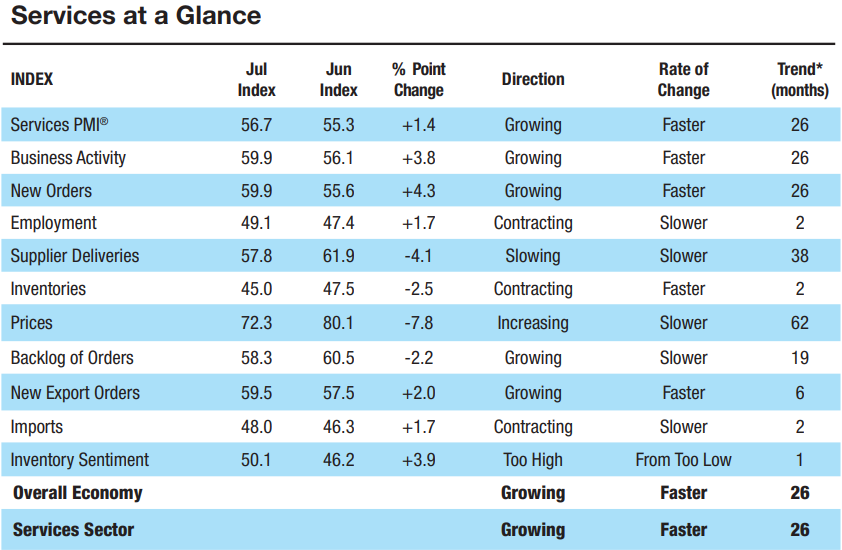U.S. Dollar Pares Loss after Services Sector Confounds Expectations
- Written by: James Skinner
-

Image © Adobe Images
The U.S. Dollar reversed earlier losses to make intraday gains over some other major currencies after the Institute for Supply Management (ISM) Services PMI confounded market expectations by rising for the month of July in contrast to the alternative barometer compiled by S&P Global.
Wednesday’s release of the ISM services sector index took the currency and bond markets by surprise when rising from 55.3 to 56.7 for last month after being lifted by sharp increases in new orders and overall business activity within the U.S. economy’s largest and most important sector.
Supplier deliveries also quickened while the prices subcomponent of the barometer fell by 7.8% in its third consecutive monthly decline, also its largest since 2017, indicating a possible moderation of inflation pressures.
“The employment sub-index also rose, but remained in contractionary territory, as survey comments highlighted challenges filling openings amidst high turnover rates,” says Katherine Judge, an economist at CIBC Capital Markets.

“These are likely being magnified by firms that aren't willing to pay enough to attract new workers, and should start to show up in a slowdown in hiring in the payrolls data,” Judge also said following a review of the ISM report.
Some 13 out of 16 sub sectors within the overall services industry reported an uptick in business activity for the month of July, leading the overall ISM Services PMI to increase in contrast to the S&P Global survey, which suggested previously that the sector had contracted sharply last month.
The decline reported by S&P Global pushed its services industry PMI back to its lowest level since June 2020.
Meanwhile, a mere three out of 16 sub sectors monitored by the ISM reported a contraction in activity for July including the retail trade, the finance and insurance sectors and agriculture, forestry and fishing sectors.
“(We are) in inventory reduction mode, attempting to match inventory levels to current lower sales trends,” was the remark of one survey respondent in the retail trade.
The survey comes just days after the Bureau of Economic Analysis said that U.S. economic output had fallen by -0.9% during the second quarter, making for a second consecutive quarterly decline that had many around the market asking aloud whether the U.S. is on the cusp of a recession.
Wednesday’s survey would suggest not.
“The ISM services index not only defied the consensus expectation for a decline but rose by the most in five months in July,” says Tim Quinlan, a senior economist at Wells Fargo.
“Despite increased concern of a downturn, there was little sign of a slowdown in the details of the report. The increase in the services index was tied to a pickup in broad activity,” Quinlan and colleague Shannon Seery said.
Evidence of a further economic slowdown in the second quarter was flagged by the Federal Reserve last week as one reason why it will be extra attentive to U.S. economic figures over the eight weeks leading up to its next monetary policy decision in September.
Chairman Jerome Powell said last Wednesday that the Fed would take into account a range of U.S. economic indicators when deciding in September whether to reduce the size of increments in which it is lifting U.S. interest rates, leading the Dollar to fall widely.
“Certainly activity has slowed and you're right the GDP report showed negative growth for two quarters in a row but you have to actually look at the composition of that growth to discern what parts of the economy are slowing,” Cleveland Federal Reserve President Loretta Mester said on Tuesday.
"The moderation we've seen in some of the numbers on activity have not yet shown through to any kind of moderation on the inflation side,” she also said in an interview with The Washington Post.
While the Fed acknowledged signs of a slowdown last week, many of the bank’s officials have also been quick to express scepticism about the notion that the economy is on the cusp of a recession and Wednesday’s data is one indication that they may be right to have reservations.
To the extent that the ISM survey’s message is replicated by other data in the weeks ahead, it could lead the Fed to feel more comfortable about continuing to lift its interest rate in large increments during the months ahead and especially if inflation does not show signs of abating in the interim.
That would in turn mean upside risks for U.S. Dollar exchange rates and renewed or otherwise ongoing headwinds for the Pound-Dollar rate.

